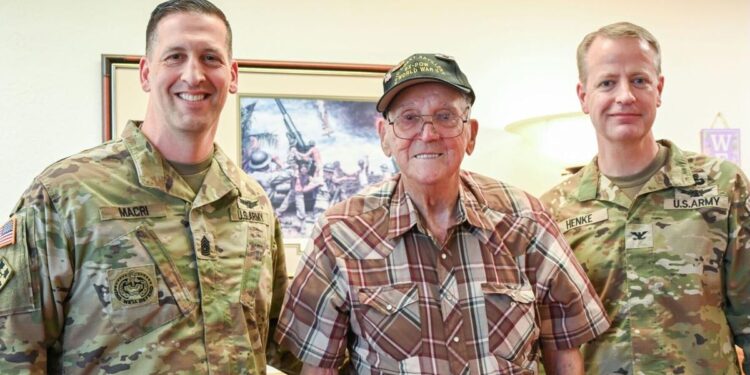Leland Chandler, 101 years old, wanted to see the home of Air Defense Artillery Aug. 12. Col. Glenn Henke, Air Defense Artillery Commandant, was happy to play host and talked with Chandler in the commandant’s office.
“Mr. Chandler is one of the original ‘First to Fire’ Air Defenders who refused to lay down their arms until given a general order in the Philippines,” Henke said. “This is the origin of our branch motto, which every ADA Soldier learns early on. He is the living embodiment of our branch heritage.”
Like many 18-year-olds, when the Japanese attacked Pearl Harbor in 1941, Chandler felt the call to serve his country. So, the young man from Table Grove, Illinois, joined the Army.
But Chandler knew he didn’t want to be in the infantry, so he volunteered for the Coastal Artillery, the precursor to today’s Air Defense Artillery.
“I had a friend who went to basic training at Chanute Air Force Base in Illinois. But it was cold there,” Chandler said. “The Army guy told me there was one other opening, but it was in the Philippines, and I said, ‘I’ll go there!’”
Chandler was stationed on the island of Corregidor as part of H Battery, 60th Coastal Artillery, where he received a quick basic training and then trained on the M3 3-inch anti-aircraft guns that lined the sandy beaches.
“When we got off that ship, the American dependents were in line to board our ship, as a sergeant told us we would be fighting the Japanese soon,” he remembered.
After bombing Pearl Harbor, the Japanese overran Guam and set their sights on the Philippine Islands. Corregidor is the largest island that guards Manila Bay. Chandler and his battle buddies knew a fight was coming.
“The Japanese pilots knew how high our 3-inch shells could go, so we never reached them those first few days,” Chandler remembered. “Then a submarine showed up with new shells and we shot down seven planes in one day!”
Once the Japanese landed on Corregidor, Chandler and his fellow artillerymen engaged in close-quarters, hand-to-hand combat with the enemy.
“They would fall down like they had been shot and then shoot us in the back when we passed by,” he said. “Our captain told us to bayonet each body we found.”
However, history shows Japanese troops, using heavy artillery and Naval bombardment, forced the surrender of the remaining American and Filipino forces May 6, 1942. The surviving military personnel were taken prisoner.
Chandler and the rest of the surviving coastal artillery Soldiers were made to collect the dead, cremating the Japanese and burying the Americans. Then, they were shipped to the Japanese mainland on what the Americans called “Hell Ships,” packed so tightly they could hardly move.
“They housed us in Osaka, in a steel mill,” he said. “They told us if their mainland was bombed, they would kill us all.”
Chandler said they endured starvation, beatings and torture. He has the scars to show for it.
Then, one day a silver American B-29 Superfortress bomber roared over and the prisoners were gobsmacked because they had been captive three-and- a-half years and had never seen a B-29.
“The bomb bay doors opened, and we thought our own guys were going to bomb us,” Chandler laughed. “But they dropped metal barrels that held dried food, clothing and Hershey candy bars. The guards were on the other side of the fence, and they didn’t like us eating the candy bars because now they were the ones with no food.”
Chandler and his fellow prisoners were liberated in August 1945 after Japan’s surrender. He admits to having animosity toward the Japanese people for about three years. Then, one day, he went to church with his new bride, Ruth, and the pastor preached forgiveness.
“I stood up and I said, ‘I forgive the Japanese. It’s over with, I don’t want to hear any more about it. It’s done.’”
Mistreatment by Japanese guards left Chandler with numerous injuries and doctors told him he wouldn’t be able to father children. However, in true Leland fashion, he and Ruth have five children and “dozens” of grandchildren, several of who joined him on the trip to Fort Sill.
In 2015, Chandler and eight other former prisoners of war participated in the Sixth American POW Delegation to Japan. During the visit, Chandler and the other former prisoners shared their stories with the Japanese representatives and engaged in discussions about the importance of reconciliation between former adversaries.
“It’s absolutely critical for Soldiers to understand the history that shaped the ADA branch,” Henke summed. “Leland’s story as both a World War II Air Defender and POW survivor remind our Soldiers of the heavy price paid by those who came before us. His will to survive his experience and continue to serve America following the war should be sources of inspiration.”
Want to reach a local audience and grow your business?
Our website is the perfect platform to connect with engaged readers in your local area.
Whether you're looking for banner ads, sponsored content, or custom promotions, we can tailor a package to meet your needs.
Contact us today to learn more about advertising opportunities!
CONTACT US NOW






